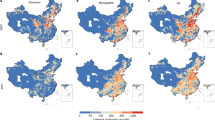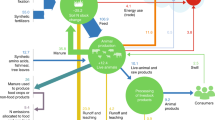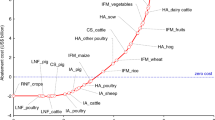Abstract
Mitigating livestock-related nitrous oxide (N2O) emissions is key for China to meet its 2060 carbon neutrality target. Here we present a comprehensive analysis of the magnitude, spatiotemporal variation and drivers of Chinese livestock N2O emissions from 1978 to 2017. We developed scenarios to explore emissions mitigation potential and associated marginal abatement costs and social benefits. The average growth rate of China’s livestock N2O emissions increased by 4.6% per year through 2006, falling sharply over 2007–2015 and gradually declining in 2017 due to a slowdown in population and meat-consumption growth rates. We estimate the technical mitigation potential of livestock N2O emissions in 2030 to be 7–21% (or 23.1–70.9 Gg N2O), with implementation costs of US$5.5 billion to US$6.0 billion. Priority regions for intervention were identified in the North China Plain, Northeast Plain and Lianghu Plain. Among mitigation opportunities, anaerobic digestion offers the greatest social benefit, while low crude protein feed is the most cost-effective option.
This is a preview of subscription content, access via your institution
Access options
Access Nature and 54 other Nature Portfolio journals
Get Nature+, our best-value online-access subscription
$29.99 / 30 days
cancel any time
Subscribe to this journal
Receive 12 digital issues and online access to articles
$119.00 per year
only $9.92 per issue
Buy this article
- Purchase on Springer Link
- Instant access to full article PDF
Prices may be subject to local taxes which are calculated during checkout




Similar content being viewed by others
Data availability
The data that support the findings of this study are available within the article and its supplementary information files, or are available from the corresponding author upon reasonable request. Source data are provided with this paper.
Code availability
The spatial analysis was run in ArcGIS v.10.2 and the statistical analysis was completed in SPSS v.13.0. All code is available upon request.
References
IPCC Climate Change 2021: The Physical Science Basis (eds Masson-Delmotte, V. et al.) (Cambridge Univ. Press, 2021).
WMO Greenhouse Gas Bulletin No. 14 (WMO, 2018).
Ravishankara, A. R., Daniel, J. S. & Portmann, R. W. Nitrous oxide (N2O): the dominant ozone-depleting substance emitted in the 21st century. Science 326, 123–125 (2009).
Tian, H. Q. et al. A comprehensive quantification of global nitrous oxide sources and sinks. Nature 586, 248–256 (2020).
Davidson, E. A. The contribution of manure and fertilizer nitrogen to atmospheric nitrous oxide since 1860. Nat. Geosci. 2, 659–662 (2009).
Herrero, M. et al. Greenhouse gas mitigation potentials in the livestock sector. Nat. Clim. Change 6, 452–461 (2016).
Frank, S. et al. Agricultural non-CO2 emission reduction potential in the context of the 1.5 degrees C target. Nat. Clim. Change 9, 66–72 (2019).
EDGAR: Emissions Database for Global Atmospheric Research v.5.0 (European Commission, 2019); https://edgar.jrc.ec.europa.eu/overview.php?v=50_AP
Bai, Z. H. et al. Nitrogen, phosphorus, and potassium flows through the manure management chain in china. Environ. Sci. Technol. 50, 13409–13418 (2016).
Duan, H. B. et al. Assessing China’s efforts to pursue the 1.5 °C warming limit. Science 372, 378–385 (2021).
Ding, T., Ning, Y. D. & Zhang, Y. Estimation of greenhouse gas emissions in China 1990–2013. Greenh. Gases 7, 1097–1115 (2017).
Global Non-CO2 Greenhouse Gas Emission Projections & Mitigation Potential: 2015–2050 (EPA, 2019).
FAOSTAT: The Food and Agriculture Organization of the United Nations Statistics (FAO, accessed 1 January 2021); https://www.fao.org/faostat/en/#data/
Kurokawa, J. et al. Emissions of air pollutants and greenhouse gases over Asian regions during 2000–2008: Regional Emission inventory in ASia (REAS) version 2. Atmos. Chem. Phys. 13, 11019–11058 (2013).
Li, N., Shang, L. W., Yu, Z. X. & Jiang, Y. Q. Estimation of agricultural greenhouse gases emission in interprovincial regions of China during 1996–2014. Nat. Hazards 100, 1037–1058 (2020).
Luo, Z. B., Lam, S. K., Fu, H., Hu, S. Y. & Chen, D. L. Temporal and spatial evolution of nitrous oxide emissions in China: assessment, strategy and recommendation. J. Clean. Prod. 223, 360–367 (2019).
Zhou, J. B., Jiang, M. M. & Chen, G. Q. Estimation of methane and nitrous oxide emission from livestock and poultry in China during 1949–2003. Energy Policy 35, 3759–3767 (2007).
Zhuang, M. H. et al. Emissions of non-CO2 greenhouse gases from livestock in China during 2000–2015: magnitude, trends and spatiotemporal patterns. J. Environ. Manage. 242, 40–45 (2019).
Zhang, C. Z. et al. Rebuilding the linkage between livestock and cropland to mitigate agricultural pollution in China. Resour. Conserv. Recycl. 144, 65–73 (2019).
Wu, H. J. et al. Nutrient-derived environmental impacts in Chinese agriculture during 1978–2015. J. Environ. Manage. 217, 762–774 (2018).
Zhou, F. et al. A new high-resolution N2O emission inventory for China in 2008. Environ. Sci. Technol. 48, 8538–8547 (2014).
Bai, Z. H. et al. China’s livestock transition: driving forces, impacts, and consequences. Sci. Adv. 4, eaar8534 (2018).
Wang, Y. et al. Mitigating greenhouse gas and ammonia emissions from swine manure management: a system analysis. Environ. Sci. Technol. 51, 4503–4511 (2017).
Zheng, J. X., Liu, J. B., Han, S. H., Wang, Y. W. & Wei, Y. S. N2O emission factors of full-scale animal manure windrow composting in cold and warm seasons. Bioresour. Technol. 316, 123905 (2020).
Ma, L. et al. Modeling nutrient flows in the food chain of China. J. Environ. Qual. 39, 1279–1289 (2010).
Thompson, R. L. et al. Acceleration of global N2O emissions seen from two decades of atmospheric inversion. Nat. Clim. Change 9, 993 (2019).
Hu, Y. C. et al. Food production in China requires intensified measures to be consistent with national and provincial environmental boundaries. Nat. Food 1, 572–582 (2020).
Robinson, T. P. et al. Global Livestock Production Systems (FAO and ILRI, 2011).
Zhang, X. M. et al. Societal benefits of halving agricultural ammonia emissions in China far exceed the abatement costs. Nat. Commun. 11, 4357 (2020).
Wei, Y. M. et al. Self-preservation strategy for approaching global warming targets in the post-Paris Agreement era. Nat. Commun. 11, 1624 (2020).
Xu, P. et al. Northward shift of historical methane emission hotspots from the livestock sector in China and assessment of potential mitigation options. Agric. For. Meteorol. 272, 1–11 (2019).
Bai, Z. H. et al. Changes in pig production in China and their effects on nitrogen and phosphorus use and losses. Environ. Sci. Technol. 48, 12742–12749 (2014).
Naylor, R. et al. Losing the links between livestock and land. Science 310, 1621–1622 (2005).
Liu, F. et al. Chinese cropland losses due to urban expansion in the past four decades. Sci. Total Environ. 650, 847–857 (2019).
Gu, B. J., Zhang, X. L., Bai, X. M., Fu, B. J. & Chen, D. L. Four steps to food security for swelling cities. Nature 566, 31–33 (2019).
Jin, S. Q. et al. Decoupling livestock and crop production at the household level in China. Nat. Sustain. 4, 48–55 (2021).
Jin, X. P. et al. Spatial planning needed to drastically reduce nitrogen and phosphorus surpluses in China’s agriculture. Environ. Sci. Technol. 54, 11894–11904 (2020).
Hou, Y., Velthof, G. L. & Oenema, O. Mitigation of ammonia, nitrous oxide and methane emissions from manure management chains: a meta-analysis and integrated assessment. Glob. Change Biol. 21, 1293–1312 (2015).
Pardo, G., Moral, R., Aguilera, E. & del Prado, A. Gaseous emissions from management of solid waste: a systematic review. Glob. Change Biol. 21, 1313–1327 (2015).
Bernal, M. P., Alburquerque, J. A. & Moral, R. Composting of animal manures and chemical criteria for compost maturity assessment. A review. Bioresour. Technol. 100, 5444–5453 (2009).
Guo, Y. X. et al. Air quality, nitrogen use efficiency and food security in China are improved by cost-effective agricultural nitrogen management. Nat. Food 1, 648–658 (2020).
Jin, X., Zhang, N., Zhao, Z., Bai, Z. & Ma, L. Nitrogen budgets of contrasting crop–livestock systems in China. Environ. Pollut. 288, 117633 (2021).
Uwizeye, A. et al. Nitrogen emissions along global livestock supply chains. Nat. Food 1, 437–446 (2020).
Bai, Z. H. et al. Food and feed trade has greatly impacted global land and nitrogen use efficiencies over 1961–2017. Nat. Food 2, 780–791 (2021).
Annual European Union greenhouse gas inventory 1990–2018 and inventory report 2020 (EEA, 2020).
Luo, Z. B., Hu, S. Y., Chen, D. J. & Zhu, B. From production to consumption: a coupled human–environmental nitrogen flow analysis in China. Environ. Sci. Technol. 52, 2025–2035 (2018).
Cui, X. Q. et al. Global mapping of crop-specific emission factors highlights hotspots of nitrous oxide mitigation. Nat. Food 2, 886–893 (2021).
Normile, D. China’s bold climate pledge earns praise—but is it feasible? Science 370, 17–18 (2020).
Asian Demographic and Human Capital Data Sheet 2018 (ADRI and IIASA, 2018).
Guiding Opinion on Coordinating and Strengthening the Work Related to Climate Change and Environmental Protection (MEE, 2021).
Du, Y. Y. et al. A global strategy to mitigate the environmental impact of China’s ruminant consumption boom. Nat. Commun. 9, 4133 (2018).
Hou, Y., Velthof, G. L., Lesschen, J. P., Staritsky, I. G. & Oenema, O. Nutrient recovery and emissions of ammonia, nitrous oxide, and methane from animal manure in Europe: effects of manure treatment technologies. Environ. Sci. Technol. 51, 375–383 (2017).
Xu, P., Koloutsou-Vakakis, S., Rood, M. J. & Luan, S. Projections of NH3 emissions from manure generated by livestock production in China to 2030 under six mitigation scenarios. Sci. Total Environ. 607, 78–86 (2017).
China Pollution Sources Census Committee. The First National Pollution Survey Census Data Set. China Environmental Science Press (2011).
Xu, P. et al. Spatial variation of reactive nitrogen emissions from China’s croplands codetermined by regional urbanization and its feedback to global climate change. Geophys. Res. Lett. 47, e2019GL086551 (2020).
Dietz, T. & Rose, E. A. Rethinking the environmental impacts of population, affluence and technology. Hum. Ecol. Rev. 1, 277–300 (1994).
Hoerl, A. E. & Kennard, R. W. Ridge regression: biased estimation for nonorthogonal problems. Technometrics 42, 80–86 (2000).
Chen, Y. D. et al. Provincial and gridded population projection for China under shared socioeconomic pathways from 2010 to 2100. Sci. Data 7, 83 (2020).
IPCC Climate Change 2014: Synthesis Report (eds Core Writing Team, Pachauri, R. K. & Meyer, L. A.) (IPCC, 2014).
Livestock and Poultry Manure Utilization Action Program (MOA, 2017).
Teng, F., Su, X. & Wang, X. Can China peak its non-CO2 GHG emissions before 2030 by implementing its nationally determined contribution? Environ. Sci. Technol. 53, 12168–12176 (2019).
Moller, K. Effects of anaerobic digestion on soil carbon and nitrogen turnover, N emissions, and soil biological activity. A review. Agron. Sustain. Dev. 35, 1021–1041 (2015).
Amann, M. et al. Cost-effective control of air quality and greenhouse gases in Europe: modeling and policy applications. Environ. Model. Softw. 26, 1489–1501 (2011).
Klimont, Z. & Winiwarter, W. in Costs of Ammonia Abatement and the Climate Co-benefits (eds Reis, S. et al.) 233–261 (Springer, 2015).
Winiwarter, W., Hoglund-Isaksson, L., Klimont, Z., Schoop, W. & Amann, M. Technical opportunities to reduce global anthropogenic emissions of nitrous oxide. Environ. Res. Lett. 13, 014011 (2018).
Klimont, Z. & Winiwarter, W. Integrated Ammonia Abatement-Modelling of Emission Control Potentials and Costs in GAINS (IIASA, 2011).
West, J. J. et al. Co-benefits of mitigating global greenhouse gas emissions for future air quality and human health. Nat. Clim. Change 3, 885–889 (2013).
Acknowledgements
This study was supported by the Strategic Priority Research Program of the Chinese Academy of Sciences (grant number XDA20100104 to Y.Z.), the National Natural Science Foundation of China (grant numbers 41905079 to P.X. and 51961125203 and 92047302 to Y.Z.) and California Strategic Growth Council Climate Change Research Program (to B.Z.H.). The effort of A.C. was partly supported by a US Department of Energy grant (DE-SC0022074).
Author information
Authors and Affiliations
Contributions
P.X. and Y.Z. designed the study. P.X. performed the research. P.X. and Y.Z. analysed the data. P.X., G.L., B.L., H.L., F.Q. and S.H. wrote the initial draft of the paper. B.Z.H., F.Z., L.M., X.L. and A.C. reviewed and revised the manuscript. All authors contributed to the discussion and interpretation of the results.
Corresponding author
Ethics declarations
Competing interests
The authors declare no competing interests.
Peer review
Peer review information
Nature Food thanks Sujong Jeong, Wenbin Wu and Xin Zhang for their contribution to the peer review of this work.
Additional information
Publisher’s note Springer Nature remains neutral with regard to jurisdictional claims in published maps and institutional affiliations.
Extended data
Extended Data Fig. 1 Changes in the relative contributions of various animals to N2O emissions from the livestock production in China for the period 1978–2017.
Changes in the relative contributions of various animals to N2O emissions from the livestock production in China for the period 1978–2017.
Extended Data Fig. 2 Changes in livestock production and emission intensities.
Changes in livestock production and emission intensities. (a) The livestock population and gross economic value of livestock production scales are on the left axis; the animal protein production scale is on the right axis. (b) N2O emission intensity of the Chinese livestock production sector (left axis) and livestock products (right axis).
Extended Data Fig. 3 Reductions in N2O emissions from the livestock production in China in 2030 under five technical mitigation scenario alternatives.
Reductions in N2O emissions from the livestock production in China in 2030 under five technical mitigation scenario alternatives. LCP represents low crude protein (LCP) feed; AD represents anaerobic digestion; CPO represents composting; CBI represents the combination of AD and composting.
Extended Data Fig. 4 Comparison of the relative contributions of selected sources to the total N2O emissions from the livestock production.
Supplementary information
Supplementary Information
Supplementary Methods and Results, Figs. 1–4 and Tables 1–5.
Source data
Source Data Fig. 1
Statistical source data.
Source Data Fig. 2
Statistical source data.
Source Data Fig. 3
Statistical source data.
Source Data Fig. 4
Statistical source data.
Source Data Extended Data Fig. 1
Statistical source data.
Source Data Extended Data Fig. 2
Statistical source data.
Source Data Extended Data Fig. 3
Statistical source data.
Source Data Extended Data Fig. 4
Statistical source data.
Rights and permissions
About this article
Cite this article
Xu, P., Houlton, B.Z., Zheng, Y. et al. Policy-enabled stabilization of nitrous oxide emissions from livestock production in China over 1978–2017. Nat Food 3, 356–366 (2022). https://doi.org/10.1038/s43016-022-00513-y
Received:
Accepted:
Published:
Issue Date:
DOI: https://doi.org/10.1038/s43016-022-00513-y
This article is cited by
-
City-level livestock methane emissions in China from 2010 to 2020
Scientific Data (2024)
-
Fertilizer management for global ammonia emission reduction
Nature (2024)
-
Wastewater-influenced estuaries are characterized by disproportionately high nitrous oxide emissions but overestimated IPCC emission factor
Communications Earth & Environment (2023)
-
Measuring ecosystem services supply and demand in rural areas: cases from China’s key counties to receive assistance in pursuing rural revitalization
Environmental Science and Pollution Research (2023)
-
Co-benefits assessment of integrated livestock and cropland system based on emergy, carbon footprint and economic return
Environmental Science and Pollution Research (2023)



